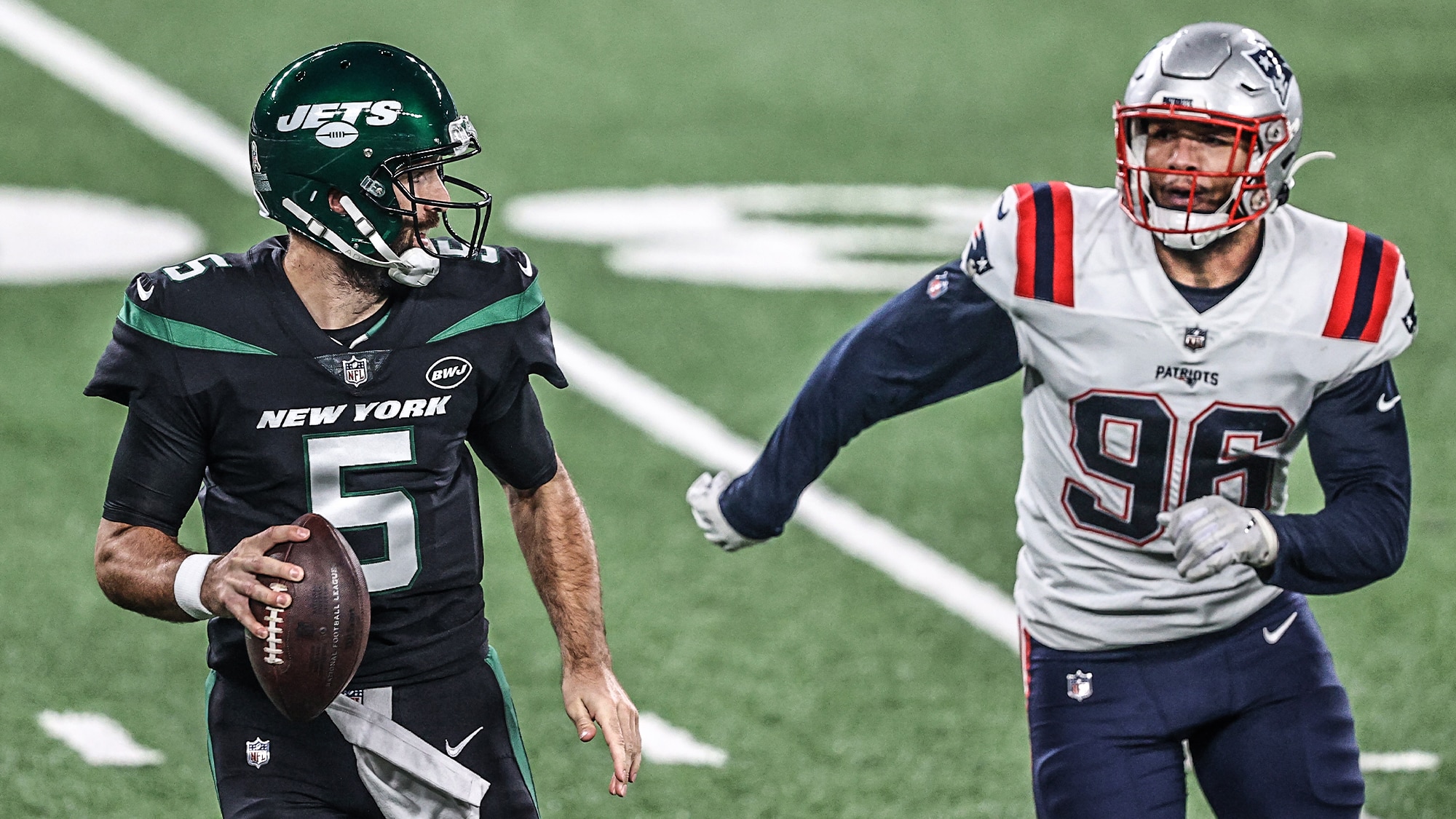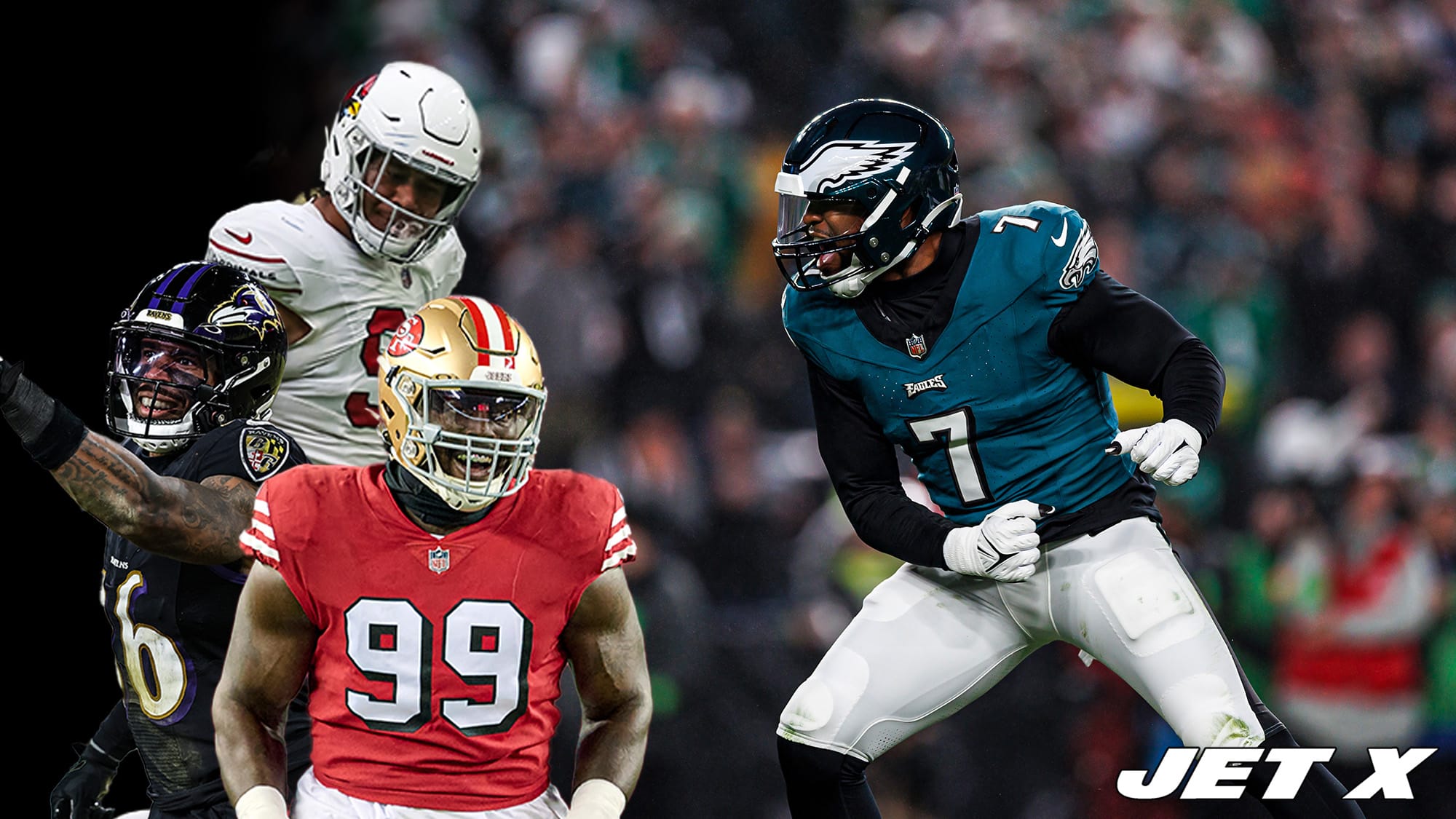Michael Nania grades every play from Joe Flacco‘s performance against the New England Patriots. How well did he actually perform?
Each week this season, I will be grading every one of Sam Darnold‘s plays from the Jets’ most recent game to get a 0-to-100 grade on the quality of his performance. Of course, Darnold did not take the field in the Jets’ Week 9 game against New England, so we will again be looking at Joe Flacco’s performance.
Sam Darnold Grades
Week 2 vs. San Francisco 49ers
Joe Flacco – Week 5 vs. Arizona Cardinals
Joe Flacco – Week 6 at Miami Dolphins
Nania’s Darnold Grades home page (links to all 2019-20 games)
Grades Explained
Digging through the All-22 film, I went back and graded every play (pass attempt, sack, rushing attempt) Flacco logged in the game, scoring each on a scale of 0-to-10 (5 representing an average play).
Anything and everything is taken into account. Ball placement. Should-be turnovers. Unlucky turnovers. Protection quality. Play-calling effectiveness. The number of open targets available and their locations on the field relative to the quarterback. Impact of the route-running and ball-tracking by the intended receiver. Down and distance. Field position. Game situation.
Every layer of decision-making is considered. Did Flacco choose the best available option? Did he scan the field to check all possible options? Did he take an over-aggressive shot when a first down was available underneath? Did he check down too early with a potential big play open down the field? Should he have tucked-and-run? Did he take a sack he should not have? Should he have thrown the ball away? Was there absolutely no option available for him to pick up yards, excusing a lack of production?
Simple statistics do not account for any of those factors. Using a manual, play-by-play grading system, many crucial variables that usually go overlooked are being properly valued. Sprinkle in this essential context, and we get a grade that is much more representative of the quarterback’s true performance level than standard box score numbers.
Flacco’s final scores are scaled from 0-to-100, with 50 representing the approximate league average (based on the analysis of other quarterbacks).
Glossary
Here is a glossary of my personally-tracked statistics, as well as some context to help you understand what good and bad numbers look like.
Overall grade: 0-to-100 grade based on the average score of all plays analyzed. (Average: 50, Max: 100, Minimum: 0)
Plays: Number of plays graded.
Positive plays: Number of plays graded above 5.0: above-average efforts. (Average: 50%, Phenomenal: >60%, Awful: <40%)
Negative plays: Number of plays graded below 5.0: below-average efforts. (Average: 30%, Phenomenal: <20%, Awful: >40%)
Positive/negative ratio: Positive plays divided by negative plays: a measure of consistency. (Average: 1.80, Phenomenal: 3.00+, Awful: <1.00)
Average positive: The average score of all positive plays (scored above 5). An indicator of how high the quarterback’s peaks were — a higher score indicates a great rate of splash plays, a lower score indicates some combination of a low number of big-time plays, many easy throws created by the supporting cast, or teammates bailing out the quarterback on subpar throws. (Average: 5.90, Phenomenal: 6.00+, Awful: <5.80)
Average negative: The average score of all negative plays (scored below 5). An indicator of how low the quarterback’s valleys were — a higher score indicates few catastrophic mistakes and/or lost plays tending to be more the supporting cast’s fault than the quarterback’s, while a lower score indicates that the quarterback’s mistakes were generally very bad and that lost plays tended to be largely his own fault. (Average: 3.80, Phenomenal: 4.00+, Awful: <3.60)
Wow Factor: Combination of average positive and average negative. An indicator of the ability to both avoid big mistakes and produce impressive moments. (Average: 9.70, Phenomenal: 10.00+, Awful: <9.40)
7+ plays: Number of plays graded 7 or better: elite moments. (Average: 8%, Phenomenal: >12%, Awful: <4%)
≤3 plays: Number of plays graded 3 or worse: brutal moments. (Average: 8%, Phenomenal: <4%, Awful: >12%)
Let’s dig in. We’ll get into my numbers on Flacco’s game against New England, compare my findings to his advanced metrics and box score statistics, and break down his best and worst plays on film.
To kick things off, here is my comprehensive 0-to-100 grade on Flacco’s performance against the Patriots.
Overall Grade
I scored Flacco with a grade of 62.4. That is the best grade I have given to either he or Darnold this season, but only by a small margin over Darnold’s game against the 49ers (61.9). Of Darnold’s 32 career games, I have scored him above a 62.4 in nine of them (28.1%), with his most recent performance above that mark being his game against the Ravens (71.9) in Week 15 of 2019.
Flacco’s composite grade this season over his three starts is currently at 49.9, while Darnold sits a few notches below at 30.9.
The 62.4 grade for Flacco’s Monday Night Football extravaganza certainly appears low when stacked up against his tremendous box score production (128.7 passer rating). The main reason for that is the severity of Flacco’s low points. While Flacco had some fantastic high points and was consistent throughout the night, the few plays that he did botch tended to be very brutal.
We have to give credit where credit is due. In their first game with all three of Jamison Crowder, Denzel Mims, and Breshad Perriman on the field, Dowell Loggains and Adam Gase coached a wonderful game. They were scheming things up so well that there was rarely an excuse for Flacco to not get something positive out of the play. In turn, Flacco had a handful of mistakes that were highly costly since they left a lot of potential yardage on the field. In addition, Flacco benefited from some big gains on plays where the read and throw were both relatively easy.
Tracking Stats
Here is a breakdown of my grading. Check out the glossary above for explanations.
Plays: 28
Positive plays: 20
Negative plays: 8
Positive/negative ratio: 2.50 (Average: 1.80, Phenomenal: 3.00+, Awful: <1.00)
Positive %: 71.4 (Average: 50%, Phenomenal: >60%, Awful: <40%)
Negative %: 28.6 (Average: 30%, Phenomenal: <20%, Awful: >40%)
Average positive: 6.12 (Average: 5.90, Phenomenal: 6.00+, Awful: <5.80)
Average negative: 3.14 (Average: 3.80, Phenomenal: 4.00+, Awful: <3.60)
Wow Factor: 9.26 (Average: 9.70, Phenomenal: 10.00+, Awful: <9.40)
7+ plays: 4 (14.3%) – (Average: 8%, Phenomenal: >12%, Awful: <4%)
≤3 plays: 4 (14.3%) – (Average: 8%, Phenomenal: <4%, Awful: >12%)
Flacco had a consistent night, as evidenced by his strong rate of positive plays and his solid positive/negative ratio, but his valleys were extremely low, dragging this down from an elite performance to merely a “good” one. While he had four outstanding plays, he also had four head-scratchers. His average positive score of 6.12 was tremendous, but his ghastly average negative score of 3.14 was even further from the norm than his average positive score.
Box Score Stats
Here is a look at Flacco’s box score stats.
18/25 (72.0%), 262 yards (10.5 Y/A), 3 touchdowns, 1 interception. 1 sack for 5 yards.
Passer rating (NFL avg ~95.0): 128.7
Flacco career rank: 5th of 175 (98th percentile)
Week 9 NFL rank: 6th of 28
Net yards per attempt (includes sack yardage, NFL avg ~6.5): 9.9
Week 9 NFL rank: 2nd of 28
Flacco had a highly productive game, averaging 10.5 yards per attempt and tossing three scores despite getting only 25 pass attempts. With only one sack taken for five yards, Flacco averaged a sterling 9.9 net yards per attempt, second-best of the week behind only Kirk Cousins (10.1).
This was arguably the best offensive performance authored by Gase and Loggains since they trekked northbound on I-95 from Miami to New Jersey. With 27 points across only eight drives, the Jets averaged 3.38 points per drive, their best-ever mark under Gase.
Advanced Stats
For comparison, here is a look at how Flacco’s performance was evaluated by a few of the advanced metrics out there.
ESPN Raw QBR: Total Quarterback Rating (0-100 with 50 average): 97.9
Week 9 NFL rank: 3rd of 28
Pro Football Focus Grade (NFL avg ~73.0): 76.0
Week 9 NFL rank: 10th of 28
Adjusted completion percentage*: 75.0%
Week 9 NFL rank: 17th of 28
*- accounts for drops, throwaways, spikes, etc, league average ~75%
Flacco posted a near-perfect QBR that trailed only Aaron Rodgers and Drew Brees in Week 9, but PFF was not as high on the performance, grading him slightly above-average and ranking him as the week’s 10th-best quarterback.
I side with PFF here. Flacco was certainly good, but his low points were too detrimental for this game to be considered elite.
Support
Here is a look at some numbers regarding the support Flacco received in the game.
Percentage of dropbacks under pressure (NFL avg ~30%): 42.3%
Week 9 NFL rank: 7th-highest of 28
Despite the lackluster pressure rate, this may have been the offensive line’s best performance. The pressure rate was pushed up by Flacco’s high average of 2.74 seconds from snap-to-release, fourth-longest of the week, as the team did not run many quick passes or screens and focused on the deep game.
The Jets held up well enough up front for Flacco to launch quite a few bombs on long-developing deep routes. It was not a perfect protection performance by any means, but it was good enough on a night where the Jets were finally getting receivers open on a consistent basis. Greg Van Roten (0 pressures allowed) and George Fant (1 pressure allowed) were the stars.
Average starting field position (NFL avg ~28.5): Own 23.5
Teammate yards per rush attempt: 3.6
Drops, throwaways, batted passes: 0, 1, 0
The offense did not benefit from great field position. None of the Jets’ eight drives started in New England territory and only one started beyond their own 26-yard line. The run game did not help Flacco out much, either. It sputtered after Mekhi Becton‘s exit, averaging 5.3 yards per attempt before his exit and just 2.5 after.
However, the receivers did not drop any passes (although Perriman had one play that could have been considered a drop but was not officially tracked as such, which we will see below) while the offensive line helped to keep Flacco to just one throwaway and zero batted passes.
Best plays
3RD & 5 AT NE 17 (Q1, 8:42) – NE 0, NYJ 0
Breshad Perriman gets a one-on-one against J.C. Jackson (an elite cover corner) on a go route up the sideline on the boundary side with no safety deep, and Flacco takes the shot. He drops the ball in nearly perfectly, but Perriman cannot haul it in. The throw could have been placed a tad more out in front, but it still hits Perriman on two hands. Jackson also may have gotten away with using his hands a bit too early.
Perriman was not credited with a drop on that play, which is understandable considering that Jackson was heavily contesting the catch.
1ST & 10 AT 50 (Q2, 10:07) – NE 7, NYJ 3
Braxton Berrios goes in motion and is followed by a defender to tip off likely man coverage. Post-snap, Flacco notices the single-high safety turn his hips to the inside, leaving Perriman one-on-one against Jackson on a go route to the boundary side once again. Flacco slides into the open space to his right and flicks the ball deep without even setting himself, dropping it in beautifully to Perriman for the 50-yard score.
1ST & 10 AT NYJ 38 (Q2, 0:36) – NYJ 13, NE 10
Forget Peyton-to-Harrison or Montana-to-Rice. Flacco-to-Perriman is where it’s at. Care for some more?
One safety deep, Perriman one-on-one on a go route up the sideline (this time on the field side) – what do you think Flacco is going to do? Perriman gets Jason McCourty to open his hips up, and that prompts Flacco to trust Perriman’s speed and hoist up the bomb. Flacco puts it in a good spot for Perriman, but McCourty hooks Perriman’s arm to prevent the catch. McCourty is hit with a pass interference penalty and the Jets are rewarded with a 42-yard gain.
1ST & 10 AT NE 20 (Q2, 0:29) – NYJ 13, NE 10
On the very next play following the pass interference, Flacco threaded one of the smallest needles the NFL has seen in recent memory. As the outermost wide receiver in the bunch to the left side (field side), Crowder runs a corner route. Flacco takes advantage of a clean pocket (largely thanks to Greg Van Roten and George Fant) and launches. The ball nestles into Crowder’s arms without forcing him to make any adjustments whatsoever. Crowder drags his back foot in-bounds for the score.
According to NFL Next Gen Stats, that throw had a completion probability of 6.2%, the most improbable completion of the 2020 season and the most improbable touchdown pass since 2017.
Joe Flacco and Jamison Crowder's 20-yard TD had a 6.2% completion probability, the most improbable completion of the season, and most improbable touchdown since 2017.
➤ Air Distance: 45.2 yds
➤ Receiver Separation: 0.9 yds
➤ Sideline Distance: 0.2 yds#NYJvsNE | #TakeFlight pic.twitter.com/dt4RIZXr0v— Next Gen Stats (@NextGenStats) November 10, 2020
Worst plays
2ND & 5 AT NYJ 26 (Q1, 2:48) – NE 7, NYJ 3
Flacco’s night could have played out much differently if this pass in the first quarter was caught by Devin McCourty. Flacco fakes the handoff and immediately looks left to Denzel Mims on the slant, completely oblivious of McCourty sinking into the hole. McCourty breaks on the ball and should snag it for a likely pick-six, but he drops it.
2ND & 8 AT NE 32 (Q2, 4:49) – NYJ 10, NE 7
A lot of yardage is left on the field here by Flacco as he misses two opportunities. Mims (highlighted pre-snap) breaks open on a dig about 12 yards downfield, but Flacco badly misfires under pressure allowed by Chuma Edoga. In addition, Jamison Crowder (highlighted during the play) toasted his man on a deep post from the left slot and was open for a 32-yard touchdown, but Flacco elected to take the safer option.
1ST & 10 AT NYJ 18 (Q4, 6:00) – NYJ 27, NE 20
Flacco only dropped back four times in the fourth quarter, and two of those plays were extremely damaging mistakes that ended up costing New York the game.
Here, the Jets are leading by seven points with six minutes left following a Patriots field goal. With an opportunity to bleed the clock and seal the game, it is imperative for Flacco to take a slow-and-steady approach and value high-percentage throws. Instead, on the first play of the drive, Flacco decides to bomb a shot to Mims on a deep post route that is headed straight into a Cover-2. Predictably, it’s picked off. Meanwhile, Perriman was wide open for a first down over the middle while Ryan Griffin and Frank Gore were wide open for safe checkdowns. This is clearly a premeditated decision. Flacco never looks anywhere else.
Turning the ball over on the first play of a clock-killing drive is about as bad as it gets, especially considering Flacco had three uncontested targets available to him and plenty of time to find them thanks to great protection.
2ND & 2 AT NYJ 34 (Q4, 1:29) – NYJ 27, NE 27
Following New England’s game-tying touchdown, the Jets kicked off their march to win the game with an eight-yard gain as Flacco dumped the ball off to La’Mical Perine. On the next play, Flacco crushed that momentum.
From the right slot, Crowder clears the linebackers and has room over the middle on a crossing route. The window is there for a big completion if Flacco gets the ball out on time and makes an anticipatory throw, but he passes on it. Perriman runs a crossing route from left-to-right and has room up the field, but Flacco passes on that as well. Ideally, you would like to see him try one of those throws, but if not, Perine is sitting all by himself in the middle of the field for an easy first down. Flacco does not even go to Perine, and winds up taking a sack.
With three plausible options, including an absolute gimme of a checkdown, taking a sack here is atrocious.
Summary
With Crowder, Mims, and Perriman all healthy for the first time in addition to a long-awaited strong game from Loggains and Gase, did Flacco enjoy better support than Darnold has in any game this season? Yes.
However, can we say for sure that Darnold would have played as well as Flacco did in the same situation? No. That is an entirely hypothetical question. It is possible that Darnold would have played worse – the Jets presented him with plenty of open receivers against Denver and he missed many of them. It is also possible he would have played similarly. Heck, maybe he would have played better.
From a raw statistical standpoint, there is no doubt that the production floor for Darnold would have been extremely high if he was healthy for the New England game and his supporting cast performed the same way it did for Flacco. With receivers open as often as they were, the coaching staff doing a good job, and the offensive line looking better, Darnold naturally would have put up better production than he has so far this season even if he performed at a similar level as he has in previous games – simply because there would be more potential production made available to him by his supporting cast.
So, yes, if Darnold had played on Monday night, he most likely would have posted his best numbers of the year.
However, the box score statistics rarely tell you the true story about a quarterback’s actual impact on the game. A quarterback’s stats are a product of the entire offense, not just himself. Just because Darnold would have put up better numbers, it does not mean he would have actually played better.
For example, Darnold’s numbers against the 49ers and Chiefs do not look much different from his numbers against the Bills (season-opener and Week 7), Colts, and Broncos, but in actuality, he played much more effective football in the San Francisco and Kansas City games than in the latter four.
That’s the point of these grades – to separate the crude results from reality. A quarterback can play great or awful under any circumstances, regardless of how many receivers are open or how much pressure he is under. On every play, the quarterback can either meet, fall short of, or exceed the value that the perfectly-average quarterback would have provided in the very same situation.
Against New England, the Jets teed things up for Flacco, but he still needed to nail some incredibly tough throws to have the strong game that he did. Darnold or the average quarterback (or even the average version of Flacco) would not be likely to hit those throws as frequently as Flacco ended up hitting them. Conversely, Flacco made some inexcusable mistakes that held him short of the phenomenal outing that he definitely could have had. The average quarterback probably would not have made as many egregious blunders in Flacco’s shoes.
Accuracy and avoiding costly blunders are two key areas where the quarterback’s performance independent of his surroundings is a huge factor. There is nothing an offense can do to help Flacco execute a throw that has a 6.2% likelihood of being completed, nor is there anything it can do to stop him from failing to see the safety and nearly throwing a pick-six. We do not know how Darnold would have compared at executing low-percentage throws or avoiding big mistakes.
The bottom line is that if you are looking to evaluate how well a quarterback plays in a given game, you have to look at his actions independent of his surroundings. He has a job to do on every play. Sometimes, that’s throwing the ball away or dumping it off, and sometimes, it’s executing a 50-yard deep bomb. Either way, the quarterback has a responsibility and should be judged according to his ability to execute that responsibility, whether it is accompanied by gaudy statistical production or not.
While Darnold would almost definitely have put up great numbers against the Patriots, we have to actually watch him play with similar support quality as Flacco got on Monday night to know exactly how well he can take advantage of favorable circumstances. Would Darnold have used the support to dominate the Patriots even more than Flacco did? Would he have played a game similar to what Flacco ended up providing – very good but featuring a few big mistakes? Or, would he have drastically limited the offense’s potential as he did against Denver?
Throughout his six games this season, Darnold has played at a level well below where he should be playing based on what his team has set up for him. As bad as his support has been, he has still fallen well short of what you would expect the average quarterback to do in the same shoes. We do not know if his below-average performance would change even if improved play from those around him raises the baseline expectations.
From 2018-19, Darnold absolutely was the type of quarterback who rose up brighter than most in favorable situations while stinking it up worse than most in unfavorable ones, but 2020 Darnold is a much different player. We need an opportunity to see him play in a well-supported game to know for sure if he is still a player who takes advantage of great support at an elite level.
For Darnold’s sake, hopefully he can come back healthy after the bye week and get seven games with a healthy Crowder/Mims/Perriman trio in addition to more coaching competency from Loggains and Gase. That way, we can start squashing the excuses and see who Darnold is once and for all.
Darnold’s struggles to this point absolutely still matter immensely – once again, we have to evaluate the quarterback independently of his surroundings no matter what – but it would certainly be nice to see what he can do with explosive receivers running free all over the field as they did for Flacco on Monday night.
With a good group around him, will Darnold lift his team even higher, go only as far as it takes him, or hold it back?















